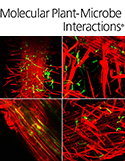Advanced Search
Protocol for RYMV Inoculation and Resistance Evaluation in Rice Seedlings
Published: Vol 8, Iss 11, Jun 5, 2018 DOI: 10.21769/BioProtoc.2863 Views: 7308
Edited by: Feng Li Reviewed by: Jinping ZhaoShankar Pant
Abstract
Rice yellow mottle virus (RYMV), a mechanically transmitted virus that causes serious damage to cultivated rice plants, is endemic to Africa. Varietal selection for resistance is considered to be the most effective and sustainable management strategy. Standardized resistance evaluation procedures are required for the identification and characterization of resistance sources. This paper describes a protocol for mechanical inoculation of rice seedlings with RYMV and two methods of resistance evaluation – one based on a symptom severity index and the other on virus detection through double antibody sandwich-enzyme linked immunosorbent assay (DAS-ELISA).
Keywords: RiceBackground
RYMV is a major biotic constraint for rice production in Africa (Séré et al., 2013) and has been reported in most rice-growing countries in Africa and Madagascar. It is not transmissible through seed (Konaté et al., 2001; Allarangaye et al., 2006) but by insect vectors (particularly beetles) and by contact during agricultural operations (Bakker, 1974; Traoré et al., 2006), especially while transplanting seedlings from seedbeds to the field. The virus is highly stable and capable of multiplying at high concentrations in its rice and wild Poaceae (Bakker, 1974) hosts.
Monitoring of RYMV incidence in seedbeds and varietal selection are the most efficient and sustainable ways of managing RYMV. There are two phenotypes of resistance – partial resistance, characterized by a delay in the appearance of symptoms (Albar et al., 1998), and high resistance, characterized by the absence of virus detection using DAS-ELISA (Ndjiondjop et al., 1999). Although partial resistance is widely distributed among Oryza sativa japonica varieties, only a few varieties from the cultivated rice species O. sativa and O. glaberrima express a high level of resistance to RYMV. Three major resistance genes – RYMV1, RYMV2 and RYMV3 – have been reported (Ndjiondjop et al., 1999; Thiémélé et al., 2010; Pidon et al., 2017).
Evaluation of the level of resistance to RYMV in rice varieties or lines and the comparison of the outcomes of different experiments require the use of a standardized protocol. This paper describes such a protocol which is based on DAS-ELISA and symptom severity. Reference accessions (susceptible, partially and highly resistant) have been included in the protocol to enable the drawing of reliable conclusions by comparing the test entry with reference materials. The number of plants tested for each variety or line is, however, not specified as it depends on the genetic material being tested and the objective of the experiment.
Materials and Reagents
- Fontainebleau sand (VWR, catalog number: VWRC27460.295 )
- Latex gloves
- 2 ml microcentrifuge tubes (Dominique DUTSCHER, catalog number: 033297 )
- 5 mm-steel beads (Brammer)
- 500 ml-wash bottle
- Plates 96 wells (VWR, catalog number: 735-0083 )
- 10, 20, 200, and 1,000 μl tips
- Paper towel
- Rice seeds, including control accessions (susceptible, partially and highly resistant)
- RYMV-infected rice leaves (fresh, dried or frozen at -20 °C)
- Carborundum 0.037 mm used as an abrasive (VWR, catalog number: 22540.298 )
- Liquid nitrogen (if possible)
- RYMV antibody (wide spectrum polyclonal antibody against purified RYMV virions – prepared as described in N’Guessan et al. (2000) and Afolabi et al. (2009), or DSMZ, catalog number: AS-0732 or RT-0732 )
- Alkaline phosphatase-conjugated polyclonal antibody against RYMV (prepared as described in Clark and Adams (1977), or DSMZ, catalog number: RT-0732 )
- Skimmed milk powder
- Substrate pNPP (para NitroPhenylPhosphate, Sigma-Aldrich, catalog number: N9389 )
- Polyvinylpyrrolidone (PVP-40), MW 40000 (VWR, catalog number: 26616.184 )
- Potassium phosphate (KH2PO4) (Sigma-Aldrich, catalog number: P0662 )
- Sodium phosphate dibasic (Na2HPO4) (Sigma-Aldrich, catalog number: S3264 )
- MilliQ water
- Sodium carbonate (Na2CO3) (Sigma-Aldrich, catalog number: S7795 )
- Sodium hydrogen carbonate (NaHCO3) (Sigma-Aldrich, catalog number: S5761 )
- Sodium chloride (NaCl) (Sigma-Aldrich, catalog number: S7653 )
- Potassium chloride (KCl) (Sigma-Aldrich, catalog number: P9333 )
- Tween 20 (Sigma-Aldrich, catalog number: P1379 )
- Diethanolamine (Fisher Scientific, catalog number: 10131470 )
- Hydrochloric acid (HCl) 10 N
- Phosphate inoculation buffer (0.1 M pH 7.2) (see Recipes)
- Buffers for ELISA test (see Recipes)
- Buffer PBST 10x
- Coating buffer pH 9.6
- Substrate buffer pH 9.8 (see Recipes)
Equipment
- Greenhouse or plant growth chamber
- Mortars and pestles
- Tissue lyser (QIAGEN, model: TissueLyser II )
- 10, 20, 200, and 1,000 μl volume pipettes
- 200 μl volume 8-channel pipette
- Vortex
- pH meter
- Microcentrifuge
- Microplate reader with 405 nm filter (TECAN, model: Infinite M200 Pro )
Procedure
Category
Plant Science > Plant immunity > Disease bioassay
Plant Science > Plant immunity > Host-microbe interactions
Biochemistry > Protein > Immunodetection
Do you have any questions about this protocol?
Post your question to gather feedback from the community. We will also invite the authors of this article to respond.
Tips for asking effective questions
+ Description
Write a detailed description. Include all information that will help others answer your question including experimental processes, conditions, and relevant images.
Share
Bluesky
X
Copy link

